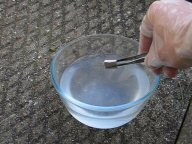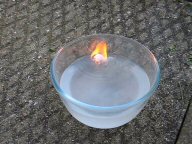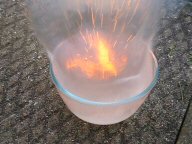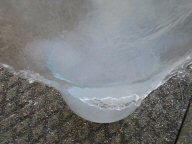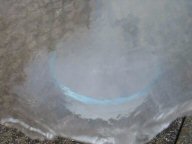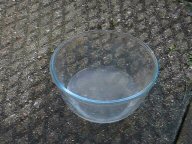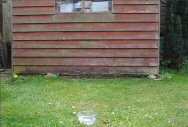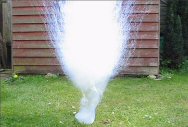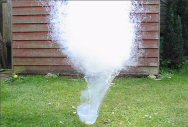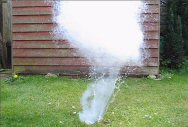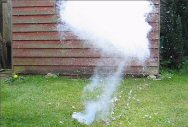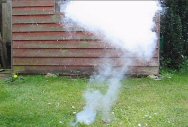Sodium Reactions
Sodium plays an important role in everyday life in the form of sodium chloride (NaCl), or as it's more commonly known, table salt. It's therefore hard to believe that sodium is in fact a soft alkali metal which reacts violently with water to produce sodium hydroxide and hydrogen gas.
2Na(s) + 2H2O(l) -> 2NaOH(aq) + H2(g)
The resulting hydrogen gas mixes with the oxygen in the air to produce an explosive combination. The reaction between the sodium and the water is exothermic (gives of heat) which can, and usually does, ignite the oxygen and hydrogen gas.
When sodium is first applied to water the Na atom loses its single valence electron to form an Na cation (Na+ ion). As H2O molecules are polar, with the O atom being slightly negative (O-) and the H atoms being slightly positive (H+), the now free Na valence electron is attracted to it. This effectively causes one of the H atoms to break free, which will later bond with another neutral H atom to become a H2 molecule. This now leaves a OH- ion and a Na+ ion, which bond to form a NaOH molecule.
The following image shows what happens when a small piece (no more than a couple of millimeters squared) of sodium is put in a bowl of water.
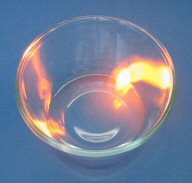 | Video |
The following sequence of images show what happens when a slightly larger piece of sodium is placed in a bowl of water. As you can see the reaction is much more violent.
| Video |
The reason for the non linear increase in the reaction, or in other words, why a slightly bigger piece of sodium has a MUCH bigger reaction, is due to the fact that the larger piece of sodium melts under the heat produced. When the sodium melts its surface area greatly increases, and a basic rule of chemistry is the bigger the surface area the bigger the reaction. This is made clearer when you think how the center of a block of sodium does not come into contact with any water until the surronding sodium has broken down. And it's only the sodium that comes into contact with the water that reacts.
In the following pictures the camera was placed further back so as to capture the thick smoke that suddenly appears.
| Video |
I assume this smoke is made up of water vapour, sodium hydroxide and molten sodium. If you view the video you can actually see bits of molten sodium falling out of the smoke. You certainly don't want your eyes anywhere near that reaction and inhaling the smoke will surely cause discomfort. So as always, eye protection, good ventilation, and distance (measured in many meters) is a must. The video and pictures above show just how fast the larger reaction happens and should act as a warning to anyone considering experimenting with sodium.
Updates
I've now found a safer location for the sodium experiments. This will allow me to try different liquids and larger amounts of sodium. I'll post the results in this section.The following sequence shows two 1cm squared blocks being placed in a half full can of coke. One of the sodium blocks definately went inside the can, but I'm not sure about the second block. I think it may have got jammed in the top of the can. I didn't fancy returning to the can to find out. The can remained intact throughout the reaction (it wasn't even dented).
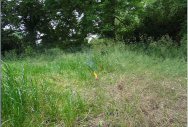 |
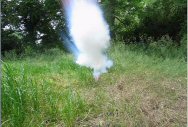 |
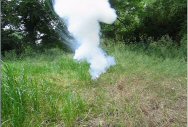 |
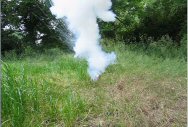 |
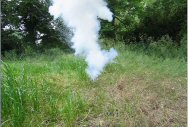 |
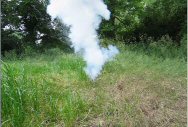 |
This sequence shows a large 1.5cm squared block being placed in a bowl of water. I was hoping to capture the entire cloud of sodium hydroxide but I had the camera to close.
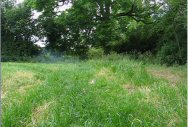 |
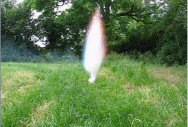 |
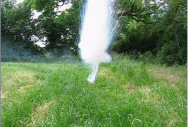 |
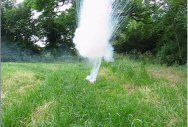 |
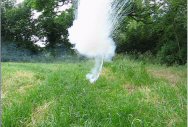 |
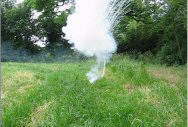 |
Check back soon for more updates...
| Home |
